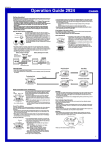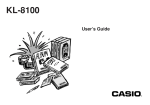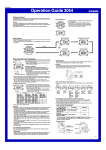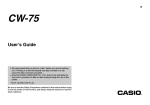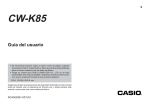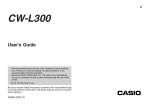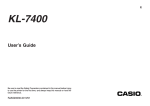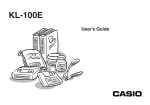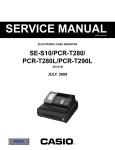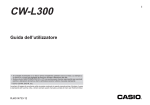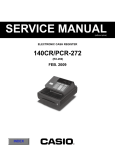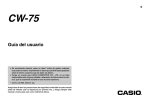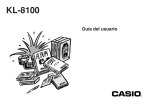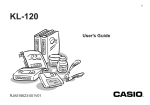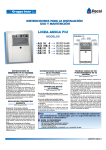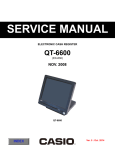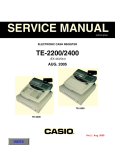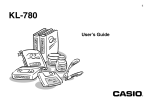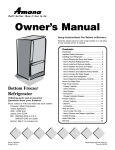Download CW-K85 User`s Guide - Support
Transcript
E CW-K85 User’s Guide • We recommend that you print on a disc* before you record anything on it. Printing on a disc that already has data recorded on it can cause the data to become corrupted. • Note that CASIO COMPUTER CO., LTD. shall not be held liable for any loss or corruption of data on discs arising through the use of this printer. * CD-R, CD-RW, DVD-R, etc. Be sure to read the Safety Precautions contained in this manual before trying to use the printer for the first time, and always keep this manual on hand for future reference. RCA502991-001V01 GUIDELINES LAID DOWN BY FCC RULES FOR USE OF THE UNIT IN THE U.S.A. (not applicable to other areas). NOTICE This equipment has been tested and found to comply with the limits for a Class B digital device, pursuant to Part 15 of the FCC Rules. These limits are designed to provide reasonable protection against harmful interference in a residential installation. This equipment generates, uses and can radiate radio frequency energy and, if not installed and used in accordance with the instructions, may cause harmful interference to radio communications. However, there is no guarantee that interference will not occur in a particular installation. If this equipment does cause harmful interference to radio or television reception, which can be determined by turning the equipment off and on, the user is encouraged to try to correct the interference by one or more of the following measures: • Reorient or relocate the receiving antenna. • Increase the separation between the equipment and receiver. • Connect the equipment into an outlet on a circuit different from that to which the receiver is connected. • Consult the dealer or an experienced radio/TV technician for help. Caution: Changes or modification to the product not expressly approved by CASIO could void the user’s authority to operate the product. FCC WARNING Changes or modifications not expressly approved by the party responsible for compliance could void the user’s authority to operate the equipment. Proper connectors must be used for connection to host computer and/or peripherals in order to meet FCC emission limits. Cable specified for PC Windows® compatible PC to CW-K85 Declaration of Conformity Model Number: CW-K85 Trade Name: CASIO COMPUTER CO., LTD. Responsible party: CASIO, INC. Address: 570 MT.PLEASANT AVENUE, DOVER, NEW JERSEY 07801 Telephone number: 201-361-5400 This device complies with Part 15 of the FCC Rules. Operation is subject to the following two conditions: (1) This device may not cause harmful interference, and (2) this device must accept any interference received, including interference that may cause undesired operation. Read This First! • CASIO COMPUTER CO., LTD. shall not be held liable for any loss or claims by you or any other person or entity that may arise through the use of this printer. • Reproduction of this manual in any form, either in part or its entirety, is forbidden without the express permission of CASIO COMPUTER CO., LTD. • The contents of the manual are subject to change without notice. Safety Precautions Thank you for purchasing this quality CASIO product. Before using it, be sure to read the following Safety Precautions. Keep the manual in a convenient location for future reference when necessary. Danger © Copyright 2006 CASIO COMPUTER CO., LTD. All rights reserved. This symbol indicates information that, if ignored or applied incorrectly, creates the danger of death or serious personal injury. • Be sure to read this manual carefully before attempting to use the product for the first time. Warning This symbol indicates information that, if ignored or applied incorrectly, creates the possibility of death or serious personal injury. Caution This symbol indicates information that, if ignored or applied incorrectly, creates the possibility of personal injury or material damage. Examples of graphic markings indicates something you should not do. The symbol shown here indicates you should not try to take the unit apart. indicates something you should do. The symbol shown here indicates you should unplug the unit from the wall outlet. 1E Danger Alkaline Batteries Power cord, AC adaptor, USB cable Perform the following steps immediately if fluid leaking from alkaline batteries ever gets into your eyes. 1. Do not rub your eyes! Rinse them with water. 2. Contact your physician immediately. Leaving alkaline battery fluid in your eyes can lead to loss of sight. Warning Smoke, abnormal odor, overheating, and other abnormalities Continued use of the product while it is emitting smoke or strange odor, or overheating creates the risk of fire and electric shock. Immediately perform the following steps whenever any of the above symptoms are present. 1. Turn off power. 2. Unplug the power cord from the wall outlet. 3. Contact your original retailer. Power cord, AC adaptor, USB cable Misuse of the power cord, AC adaptor, or USB cable creates the risk of fire and electric shock. Make sure you follow the precautions listed below. • Use only items that are specified for the product. • Use only a power source whose output matches the rating marked on the plate on the back of the product. • Never plug the power cord into a wall outlet that is shared by other devices, or into a shared extension cord. E 2 Warning Misuse of the power cord, AC adaptor, or USB cable can damage it and create the risk of fire and electric shock. Make sure you follow the precautions listed below. • Never place heavy objects on these items or subject them to direct heat. • Never modify these items or subject them to bending. • Do not subject these items to twisting or pulling. • Should the power cord, AC adaptor, or USB cable or its plug ever become damaged, contact your original retailer. Power cord, AC adaptor, USB cable • • • Never touch the power cord, AC adaptor, or USB cable or its plugs while your hands are wet. Doing so creates the risk of electric shock. Never use the power cord or AC adaptor in areas where it may become wet. Water creates the risk of fire and electric shock. Never place a vase or any other liquid container on top of the power cord, AC adaptor, or USB cable. Water creates the risk of fire and electric shock. Batteries Misuse of batteries can cause them to leak, resulting in damage to nearby objects, or to explode, creating the risk of fire and personal injury. Always make sure you observe the following precautions. • Never try to take batteries apart or allow them to become shorted. • Never expose batteries to heat or dispose of them by incineration. • Never mix old batteries with new ones. • Never mix batteries of different types. • Do not charge the batteries. • Make sure the positive (+) and negative (–) ends of the batteries are facing correctly. Caution Warning Dropping and rough treatment Continued use of the product after it has been damaged due to dropping or other rough treatment creates the risk of fire and electric shock. Immediately perform the following steps if the product should ever become damaged. 1. Turn off power. 2. Unplug the power cord from the wall outlet. 3. Contact your original retailer. Do not disassemble or modify the product. Never try to take the product apart or modify it in any way. Doing so creates the risk of electric shock, burn injury, or other personal injury. Leave all internal inspection, maintenance, and repair up to your original retailer. Water and foreign objects Water, liquids, or foreign objects (especially metal) getting inside the product creates the risk of fire and electric shock. Immediately perform the following steps if liquid or a foreign object should ever get inside the product. 1. Turn off power. 2. Unplug the power cord from the wall outlet. 3. Contact your original retailer. Do not incinerate. Never dispose of the product by incineration. Doing so creates the risk of fire and personal injury due to explosion. Power cord, AC adaptor, USB cable Misuse of the power cord, AC adaptor, or USB cable can damage it and create the risk of fire and electric shock. Make sure you follow the precautions listed below. • Never locate these items near a stove or other source of intense heat. • When unplugging the power cord and USB cable, be sure to grasp the plug. Never pull on the cord or cable. • Plug in the power cord into the wall outlet as far as it will go. • Plug in the USB cable into the computer and the printer as far as it will go. • Before leaving the product unattended for long periods (such as when you go on a trip), unplug the power cord and USB cable. • When not using the printer, be sure to unplug the AC adaptor from the power outlet and disconnect the USB cable from the printer's USB port. • At least once a year, clean away any dust built up in the area around the prongs of the power cord’s plug. Batteries Misuse of batteries can cause them to leak resulting in damage to nearby objects, or to explode, creating the risk of fire and personal injury. Always make sure you observe the following precautions. • Use only batteries that are specified for use with this product. • Remove batteries from the product if you do not plan to use it for a long time. Plastic bag precaution Never place the plastic bags in which the product comes packed over your head. Doing so creates the risk of suffocation. Particular care is required in households where young children are present. 3E Caution Connection precaution Connect only items that are specified for the product to its connectors. Connecting a non-specified item creates the risk of fire and electric shock. Caution Loading and replacing batteries The springs inside of the battery compartment have sharp edges. Take care that you do not touch the springs with your fingers when loading or replacing batteries. Doing so creates the risk of personal injury. Keep backup copies of all important data Be sure that you keep separate copies of important data in a notebook or some other location. Malfunction of the product, repairs, and dead batteries can cause data stored memory to be lost. Keep heavy objects off. Never place a heavy object on top of the product. Doing so can cause the object to lose balance and fall, creating the risk of personal injury. Location Avoid the locations listed below for the product. Such locations create the risk of fire and electric shock. • Areas subject to high humidity and large amounts of dust • Food preparation areas or other location subjected to oil steam • Near heaters, on a heated carpet, in direct sunlight, in a closed vehicle parked in the sun, and other areas subjected to high heat. Avoid unstable surfaces. Never place the product on an unstable table, desk, etc. Doing so can cause the product to fall, creating the risk of personal injury. E 4 Display Screen • • • • Never push on the display screen’s LCD panel or subject it to strong impact. Doing so can cause the LCD panel’s glass to crack, creating the risk of personal injury. Should the LCD panel ever crack or break, never touch the liquid inside of the panel. LCD panel liquid can cause skin irritation. Should LCD panel liquid ever get inside your mouth, immediately wash out your mouth with water and contact your physician. Should LCD panel liquid ever get into your eyes or onto your skin, rinse with clear water for at least 15 minutes, and then contact a physician. High temperature precaution Never touch the print head or other metal objects near the head. These items become very hot, and touching them creates the risk of burn injury. Operating Precautions Contents Observe the following precautions to ensure that the printer provides you with the years of trouble-free operation for which it is designed. • Avoid using the printer in areas exposed to direct sunlight, and in areas subjected to high humidity, electrostatic charge, sudden temperature changes, and temperature extremes. Operating Temperature Range: 10°C to 35°C (50°F to 95°F) • Never subject the printer to strong impact or shock. • Never allow paper clips, pins, or other similar objects to get inside the printer mechanism. • Place the printer on a level surface when printing. A tilted surface can make normal printing impossible. • Unclear printing can indicate a dirty print head. If printing becomes unclear, use the procedures on page 46 to clean the print head. • Using the printer in a location where it is exposed to direct sunlight or other strong light can cause malfunction of its photo sensor. Use the printer in a location where it is not exposed to strong light. Safety Precautions ................................................................ 1 Operating Precautions .......................................................... 5 CW-K85 Printer Features ...................................................... 7 General Guide ........................................................................ 8 Power Requirements ............................................................. 9 Using the AC Adaptor ....................................................... 9 Using batteries ................................................................ 10 Initializing Printer Memory ................................................. 12 To initialize printer memory ............................................. 12 Data Error ....................................................................... 12 Powering Up and Selecting a Printing Mode .................... 12 To turn power on and off ................................................. 12 Auto Power Off ................................................................ 13 Mode Selection Basics .................................................... 14 Loading and Removing an Ink Ribbon Cassette .............. 15 To load the ink ribbon cassette ....................................... 15 To remove the ink ribbon cassette .................................. 16 Using the Printer’s Keys ..................................................... 17 Display Symbols and Indicators ........................................ 18 Label Printing Basics .......................................................... 19 Label Printing General Procedure ................................... 19 DISC Label Data .................................................................. 25 Disc Printing Terms ............................................................. 25 Creating Disc Label Data .................................................... 25 Creating a New Label .......................................................... 26 Inserting a Logo Into a Label ............................................. 28 Built In Logos .................................................................. 28 5E Output Samples .............................................................. 29 To insert a logo into a label ............................................. 29 To edit a phrase memory record ..................................... 38 To delete a phrase memory record ................................. 38 Inserting a Frame Into a Label ........................................... 30 Using Copy and Paste ........................................................ 38 User Characters .................................................................. 39 Output Samples .............................................................. 30 To insert a frame into a label ........................................... 30 Inputting Text into an AUTO Format .................................. 31 To recall a user character ................................................ 40 To delete a user character ............................................... 40 To input text into an AUTO format label ........................... 31 Specifying Character Spacing ........................................... 31 Controlling the Appearance of Text ................................... 41 To turn proportional spacing on and off .......................... 31 Selecting a Font .................................................................. 41 Specifying Text Alignment .................................................. 32 To specify text alignment ................................................. 32 SMALL FONT ................................................................. 41 To change the default font setting ................................... 42 To change the font of text you have just input ................. 42 Inputting and Editing Label Text ........................................ 33 Using STYLE Menu Attributes ........................................... 42 Moving the Cursor .............................................................. 33 Basic Alpha Numeric Input ................................................ 33 Saving, Recalling and Deleting Labels .............................. 44 To input alpha-numeric characters .................................. 33 About the CODE key ....................................................... 34 Inputting Symbols and Special Characters ...................... 34 To save a label ................................................................ 44 To recall a label ............................................................... 44 To delete a label .............................................................. 44 To use the SYMBOL menu .............................................. 34 Configuring the Printer Setup ............................................ 45 Inputting Illustrations ......................................................... 35 Demo Printing ................................................................. 45 To input illustrations ......................................................... 35 Deleting an Individual Character ....................................... 35 Reference ............................................................................. 46 To delete a character using the BS key ........................... 35 To delete a character using the DEL key ........................ 35 Caring for the Printer .......................................................... 46 Troubleshooting .................................................................. 47 Error Messages ................................................................... 49 Illustrations .......................................................................... 52 Symbols, Dingbats, and Special Characters .................... 52 Frames ................................................................................. 53 Label Formats ...................................................................... 54 Specifications ...................................................................... 56 Clearing Input Text .............................................................. 36 To clear all text ................................................................ 36 Text Editing .......................................................................... 36 To switch between overwrite and insert .......................... 36 Using Phrase Memory ........................................................ 37 To recall a phrase ............................................................ 37 To create new phrase memory text ................................. 37 To save input text in phrase memory ............................... 37 E 6 CW-K85 Printer Features The CW-K85 makes it possible to print on discs without connecting to a computer or installing any special software. A selection of illustrations and fonts makes labels stylish and informative. 7E General Guide Display Cassette cover Open this cover to load or remove the ink ribbon cassette. USB port For connection of a USB cable when exchanging data with a computer. Battery cover Keyboard AC adaptor terminal Connect the AC adaptor here. Slit Slide the disc to be printed into the slit. Press to turn off power. Press to turn on power. Print Head Release Button Hole If you cannot remove the disc from the printer due to printer malfunction, try performing the following steps to remove the disc. 1 Press OFF. 2 While holding down the D and H keys, press ON. If you are still unable to remove the disc after performing the above operations, perform the following steps to remove the disc from the printer. Normally, you should not use the following procedure to release the print head. Use this procedure only when the print head fails to release normally due to malfunction. E 8 1. Insert a thin object* into the hole and slide in the direction indicated by the arrow. • This will cause the print head to release the disc so you can remove it from the printer. 2. The release lever will return to its original position automatically. * Use an object that is at least 30mm (1-3/16") long and no thicker than 1.5mm (1/16"). Do not use a toothpick or other object with an easily breakable tip. Doing so creates the risk of printer malfunction. Power Requirements Depending on your printer model it may come either with an AC adaptor and power cord, or with eight AA-size alkaline batteries. • For a model that comes with an AC adaptor You can run the printer by using its bundled AC adaptor to plug it into a power outlet. • For a model that comes with batteries Load the eight batteries that come with the printer. ■ Opening and Closing the Cassette Cover Press the cassette cover release to open the cover. Using the AC Adaptor Use AC adaptor (AD-A12280L) when you want to plug into a household power outlet. ■ To connect the AC adaptor To close the cassette cover • When closing the cover, hook it onto the printer at the location shown in the illustration and then swing the cover closed. • Press down on the cassette cover until you hear it click securely closed. Important! • Use only the special AC adaptor (AD-A12280L). • Whenever switching between battery power and AC adaptor power, be sure to first turn off the printer. Only then should you connect the AC adaptor or load batteries. Connecting the AC adaptor or loading batteries while the printer is on can cause power to turn off automatically and result in loss of text data you are working on. 1. Connect the power cord to the AC adaptor. Important! • Take care when opening and closing the cassette cover, and never try to force it past its normal range of movement. Excessive force creates the risk of malfunction of and damage to the printer. 9E 2. Connect the AC adaptor plug to the printer’s AC adaptor terminal (1), and then plug the power cord into a household power outlet (2). 1 2 • Take care that you do not excessively bend or twist, or pull on either end of the power cord (points marked A and B in the illustration). Take care that the power cord is not bent excessively at these points when storing the cord. Any of the conditions mentioned above can cause breaks in the wiring of the cord. A B Using Batteries Note • The printer can run on eight AA-size alkaline batteries. Be sure to use alkaline batteries only. 1. Turn over the printer and remove the bat- ■ To disconnect the AC adaptor Important! • Never disconnect the AC adaptor while a printing operation is in progress. Doing so creates the risk of printer malfunction. • Never disconnect the AC adaptor or remove the batteries while the printer is turned on. Also, make sure that the display is completely blank after turning off the printer before disconnecting the AC adaptor or removing the batteries. Disconnecting the AC adaptor or removing the batteries at the wrong time can cause loss of text you are working on, as well as data you have stored in printer memory. tery cover. • Never bend or twist the battery cover, or otherwise subject it to rough handling. Doing so creates the risk of printer malfunction. 1. Unplug the power cord from the wall outlet (1), and then unplug the AC adaptor from the printer (2). 2 1 2. Load a set of eight new batteries. • Make sure the positive g and negative h poles of the batteries are facing in the proper directions. E 10 3. Replace the battery cover. Memory Data Backup • • Never disconnect the AC adaptor or remove the batteries while the printer is turned on. Doing so can cause loss of text you are working on, as well as data you have stored in printer memory. Be sure to keep separate backup copies of all important data you have stored in printer memory. Important! • The printer may suddenly turn off during printing if battery power goes low. Because of this, use of the special AC adaptor (AD-A12280L) is recommended to power the printer. • Because of the affect cold has on batteries, the “LOW BATTERY!” may appear prematurely when the temperature is below 10˚C(50˚F). If this happens, move the printer to a location where the temperature is within the operating temperature range (10˚C to 35˚C (50˚F to 95˚F)) • Never disconnect the AC adaptor or remove the batteries while the printer is turned on. Also, make sure that the display is completely blank after turning off the printer before disconnecting the AC adaptor or removing the batteries. Disconnecting the AC adaptor or removing the batteries at the wrong time can cause loss of text you are working on, as well as text and preset phrases you have stored in printer memory. • Whenever switching between battery power and AC adaptor power, be sure to first turn off the printer. Only then should you connect the AC adaptor or load batteries. Connecting the AC adaptor or loading batteries while the printer is on can cause power to turn off automatically, resulting in loss of text data you are working on. Battery Life • Printing of approximately 150 discs* Normal temperature (20˚C (68˚F)), one printing per disc. * When printing text or graphics that contain large areas of black, and printing under cold temperatures can shorten battery life for label printing. • Be sure to replace batteries at least once every two years, even if you do not use the printer during that period. 11 E Initializing Printer Memory Powering Up and Selecting a Printing Mode You should initialize the memory of the printer before using it for the first time, after you have not used it for a long time, or if it fails to operate normally when you turn power on. Turning the printer on and off is as simple as pressing a button. After the printer powers up, you will need to select the type of operation you want to perform. Important! Initializing printer memory clears its memory of all input data. To turn power on and off To initialize printer memory 1. Make sure that the printer is turned off. 2. While holding down the PRINT and ESC keys, press . Release first, but keep PRINT and ESC depressed until power turns on and a confirmation message appears on the display. 1. Press the button to turn the printer on. • This turns on power and displays a main menu screen like the one shown below. • The selection boundary indicates the icon that is currently selected on the main menu. 3. In response to the confirmation message that appears, press SET to initialize the printer memory or ESC to abort. Data Error Whenever you turn on the printer, it performs an internal check of its memory and functions. If it finds a serious data problem, it will display the following message: DATA ERROR! INITIALIZE THE PRINTER! When this message appears, press any key. Next, in response to the “INITIALIZE? SET/ESC” message that appears, press SET to initialize printer memory (which deletes everything in memory) or ESC to clear the message without initializing. E 12 Last Data icon New data icon Stored data icon Selection boundary Currently selected function (icon) Shows the function of the currently selected icon 2. What you should do after turning on power depends on the type of printing operation you want to perform. • See “Mode Selection Basics” on page 14 for more information. 3. To turn the printer off, press the button. Auto Power Off The printer automatically turns off if you do not perform any key operation for about six minutes. To restore power, press . Note Auto Power Off is disabled while the printer is being powered by the AC adaptor and is connected to a computer. Important • See page 45 for information about configuring contrast, print density, and language (English, German, French, Italian, Spanish) settings. • All of the display examples in this User’s Guide use English as the display language. 13 E Mode Selection Basics The illustration below shows the basic flow for mode selection after turning on the printer. To input new label text ••• To recall previously saved text into a label To display the text you were working on the last time you were using the printer (LAST DATA) • Producing a demo print (page 45) or initializing printer memory will delete any data you were last working on. E 14 Loading and Removing an Ink Ribbon Cassette An ink ribbon cassette is required when printing disc labels. You should use only the special ink ribbon cassettes that are specified for this printer. 4. Load the ink ribbon cassette into the printer. • Make sure that the ink ribbon passes between the print head and the rubber roller as shown in the illustration below. Take care that the ink ribbon does not snag on the protrusion near the print head. Press down on the ink ribbon cassette until you hear them click securely into place. Rubber roller To load the ink ribbon cassette Ink ribbon Print head 1. Open the cassette cover. 2. Remove the stopper from the ink ribbon cassette. Stopper 3. If there is slack in the ink ribbon, use your fingers as shown in the illustration to rotate the spindle of the cassette to remove the slack. • You may need to rotate the spindle several times if there is a lot of slack. Important! • Never pull on the ink ribbon with excessive force or try to push the ink ribbon into the cassette. • Loading the ink ribbon cassette while the ink ribbon is slack creates the risk of malfunction. Important! • Installing the ink ribbon cassette incorrectly or failing to secure them properly in place can cause the ribbon to break. 5. Close the cassette cover. • Press down on the cassette cover until you hear it click securely into place. Rotate in the direction of the arrow. 15 E To remove the ink ribbon cassette 1. Open the cassette cover. 2. Grasping both sides of the ink ribbon cassette, lift it straight up. Storing a Partially Used Ink Ribbon Cassette Install a stopper on the partially used ink ribbon cassette, place the cassette into its plastic bag, and then into its box. Store it where it will not be exposed to dirt and dust. Number of Prints Per Ink Ribbon Cassette • Upper or Lower Area Only: Approximately 40 prints • Upper and Lower Area: Approximately 20 prints Upper area Lower area E 16 Using the Printer’s Keys w q 9 0 1 2 3 5 6 4 8 1 • Press to print. • Press and then this key to preview the label you are currently creating. 2 Press to print data created on a computer. 3 • Pastes previously copied text. • To copy, input the text to be copied. Next, press and then this key. For more information, see page 38. 4 Press to store and recall often-used words and phrases. 5 Press to delete the character to the left of the cursor. • Press and then this key to delete all of the text you are currently inputting. 6 Press to delete the character at the current cursor location. 7 Use these keys to move the cursor on the display. 8 Press to execute a command of operation. 9 Press to temporarily shift the keyboard between uppercase and lowercase for input of one character only. For details, see page 33. 0 Press to shift the keyboard between uppercase and lowercase. For details, see page 33. q Press to activate the functions marked above, or next to keyboard keys in same color as “FUNCTION”. w Press to cancel the current operation and return to the operation before it. 7 17 E 2 CAPS On/Off indicator/Insert/Overwrite indicator “AB” indicates uppercase insert, while “ab” indicates lowercase insert. “ indicates uppercase overwrite, while “ ” indicates lowercase overwrite. Display Symbols and Indicators Before actually using the printer, you should first take some time to become acquainted with the symbols and indicators used on the label printer display. ■ Symbols and Indicators 2 3 0 SANS-SERIF SANS-S ITC SANS-S RND ROMAN ROMAN ITC SMALL FONT 9 cursor 8 w 7 5 q 6 1 Function/Shift/Code indicator appears when you press the FUNCTION key. Pressing a key while this indicator is on the display causes the function marked above, or next to that key to be executed. appears when you press the SHIFT key. While this indicator is on the display, the keyboard is shifted, so the letter keys input the opposite of their current uppercase/lowercase setting. The number keys input the punctuation symbols marked in the upper right corners of the keys. The keyboard automatically unshifts (and the shift indicator disappears) as soon as you input a character. appears when you press the CODE key. While this indicator is on the display, number keys input the accents marked above them and the U, O, P, A, S, J, K, L, Z, C, and N keys input the special characters marked in their lower right corners. The keyboard automatically returns to normal (and the code indicator disappears) as soon as you input an accent. appears when both the SHIFT and CODE keys are pressed. 18 5 Font Indicators A pointer appears next to the currently selected font. 6 Small font indicator A pointer appears here when the SMALL FONT is selected automatically by the printer. 7 Label format Shows the format of the label being created. 4 E 3 Character style indicators A pointer appears under the currently selected character style. You can select between normal (no indicator display), bold (A), outline ( ), shadow ( ), and raised ( ). 4 Scroll indicators These indicators appear when there is data above or below the currently displayed screen. 4 1 ” 8 Auto format indicator This indicator appears when Auto Format is enabled. 9 Text area This is where text appears during input and editing. 0 Character count These values indicate the character count as shown below 13/24 CHR Maximum number of allowable characters Number of characters input q Size indicator This indicator appears when you are using Auto Format. This indicator: x1 x2 x3 x4 x5 Means this: 3 mm (1Ú8") 6 mm (1Ú4") 9 mm (3Ú8") 12 mm (1Ú2") 15 mm (5Ú8") w Upper/lower label indicator This indicator shows the label (upper or lower) that is currently selected for text input. Label Printing Basics This section contains general procedures for laying out and printing disc labels. Disc Label Printing General Procedure Connect the AC adaptor (Page 9). Or load batteries into the printer. (Page 10) Load an ink ribbon cassette (Page 15). Select the print pattern you want to use (Page 20). Select the format and input its text. Print the label (Page 21). ■ To create a label for the upper print area of a disc Example 19 E 1. Press 6. After inputting the text press SET. to turn on the printer. • A LAST DATA icon will also appear on the Main Menu if there is input data left over from the last time you used the printer. See page 14 for more information. 2. Use and • Now you can preview your disc label (“To check the appearance of a disc label layout”, page 21) or print it without previewing (“To print a disc label in the upper label area”, page 21). to select NEW, and then press SET. • This displays a print pattern selection screen. AREA A Print Pattern AREA A Example AREA B 3. Use PROFILE AREA B PROFILE DATA DATA and PROFILE DATA to select the print area(s) you want, and then press SET. • Here we will select print area A (upper only). 4. Use and to select the label format you want, and then press SET. • Here we will select FORMAT 1. 5. Input the text you want. • Here we will input “PROFILE DATA”. • See “Inputting and Editing Label Text” on page 33 for information about inputting text. E 20 Controlling the Appearance of Your Disc Label When creating a disc label, you can use the following procedures to select the font, style, and layout. • Font: Page 41 • Style: Page 42 • Layout: Page 31 ■ To check the appearance of a disc label layout 1. Press FUNCTION and then PREVIEW. Note • It is recommended that you print on a disc before you record anything on it. Note that CASIO COMPUTER CO., LTD. will not be held responsible for any data that is lost during printing. • Before printing, be sure to check the “Printing Precautions” and make sure the disc you are about to print on is acceptable. • Do not try to print on a single CD-R or a business card size CD-R disc. Trying to print on such discs can damage the printer. This printer supports printing on 12cm diameter discs only. • Place the printer on a level surface when printing. A tilted surface can make normal printing impossible. • This will cause an image of the disc label layout to scroll on the display. • If the disc label layout has text in both the upper print area (AREA A) and the lower print area (AREA B), a print area selection screen will appear here. Use and to select the print area you want to preview and then press SET to scroll the print area’s layout on the display. 2. To pause scrolling at any point, press SET. • Press SET again to resume scrolling. • While scrolling is paused, you can use to screen. • To stop the preview, press ESC. ■ To print a disc label in the upper label area 1. Make sure an ink ribbon cassette is loaded in the printer (page 15). and to skip from screen Note • Characters or illustrations with very fine lines may not appear correctly on the preview screen. • It may take some time for the label image to appear on the display if it contains a large number of characters or lines. • Actual final printing may be different from the preview image that is shown on the display. 2. After performing steps 1 through 6 under “To create a label for the upper print area of a disc”, use and to select PRINT, and then press SET. 3. With the area of the disc you want to print on facing downwards, slide the disc from right to left into the slit along the top of the printer. • Never insert anything besides discs into the slit. • If the disc has a logo or any other markings on it, be sure to position it so printing will be performed in an area that is blank. 21 E Important! • Handle the disc gently when sliding it into place. Rough handling can damage the disc. • Check to make sure that there is no dirt, dust, or other foreign matter on the disc. Dirt or dust can scratch the recording surface of the disc and make it impossible to record data onto it. • Sliding the disc onto the slit with the recording side facing you will result in printing on the recording side of the disc, which will make the disc unrecordable. 4. Slide the disc to the left as far as it will go. • Make sure you slide the disc to the left as far as it will go. Normal printing may not be possible if the disc is not positioned properly inside the printer. 6. Press SET to start printing. Important! • Never turn off the printer while it is performing a print operation. • Make sure there is nothing to the right of the printer that can obstruct movement of the disc when it exits the slit. • Never touch the disc while a print operation is in progress. Doing so can scratch the disc or cause malfunction of the printer. • Never open the cassette cover while printing is in progress or while a disc is inserted in the printer. Doing so can scratch the disc or cause malfunction of the printer. • If you have a problem removing a disc due to printer malfunction, try using the procedure on page 8 to remove it. 7. When printing is complete, the disc will stop moving and the screen shown here will appear on the display. 5. Use the positioning guide to position the disc. Important! • Never use the positioning guide for any other purpose besides aligning discs. After positioning the disc, be sure to remove the positioning guide before you start printing. Positioning guide Printing will appear here. • Adjust the position of the disc so its logo or marking is parallel with the positioning guide and slit. • Note that the printer cannot print in an area of the disc that already has a logo or other markings. • You can skip this step if the disc you are using does not have a logo or other markings on it. E 22 8. Pull the disc to the right and remove it from the printer. Important! • If you have trouble removing the disc from the printer, see page 8. ■ To create a disc label for the upper and lower print areas Important! • Never turn off the printer while it is performing a print operation. • Never touch the disc while a print operation is in progress. Doing so can scratch the disc or cause malfunction of the printer. • Never open the cassette cover while a print operation is in progress. Doing so can scratch the disc or cause malfunction of the printer. 1. In step 3 of the procedure under “To create a label for the upper print area of a disc” on page 19, select the icon that shows both AREA A and AREA B, and then input text into both areas. 2. After inputting the text for the label, press SET. • Now you can preview your disc label (“To check the appearance of a disc label layout”, page 21) or print it without previewing (see below). 3. Use and 4. When printing is complete, the disc will stop moving and the screen shown here will appear on the display. 5. Remove the disc from the printer. • See step 8 on page 22 for details. 6. Use 7. Rotate the disc and reinsert it into the printer. to select PRINT, and then press SET. ■ To print a disc label in the upper and lower print areas Note • It is recommended that you print on a disc before you record anything on it. Note that CASIO COMPUTER CO., LTD. will not be held responsible for any data that is lost during printing. • Before printing, be sure to check the “Printing Precautions” and make sure the disc you are about to print on is acceptable. • Do not try to print on a single CD-R or a business card size CD-R disc. Trying to print on such discs can damage the printer. This printer supports printing on 12cm diameter discs only. and to select AREA B and then press SET. Positioning guide Adjust the angle of the disc so the second printing is aligned correctly with the first printing. 1. Use Upper print area (AREA A) and to select the upper print area (AREA A) or the lower area (AREA B), and then press SET. • Here we will select AREA A. Lower print area (AREA B) 2. Insert a disc into the printer. • See steps 3 through 5 under “To print a disc label in the upper label area” on pages 21 and 22 for details. Important! • Never use the positioning guide for any other purpose besides aligning discs. After positioning the disc, be sure to remove the positioning guide before you start printing. 3. Press SET to start printing. 8. Press SET to start printing. 9. After printing is complete remove the disc from the printer. • See step 8 on page 22 for details. 23 E ■ To exit the printing operation 1. When the screen shown above is on the display, use and to select EXIT, and then press SET twice. • This will display the main menu screen. • See page 44 for information about using the STORE option on the above screen. E 24 DISC Label Data Creating Disc Label Data The following are the general steps when preparing data for disc labeling. After inputting the required data, you can then use it to print directly onto the disc. Disc Printing Terms The following defines a few disc printing terms that are used in this part of the manual. ■ Print Surface Getting Ready • Connect the AC adaptor or load batteries (page 9). • Load an ink ribbon cassette (page 15). General Flow for Creating a Disc Label This is the side of the disc that the printer will print on. Some discs may have manufacturer logos or other information pre-printed on this side. ■ Print Data This is the text, illustrations,and all other items that the printer will print onto the print surface of the disc. SPEECH Print data 1. To create a new label from scratch, select NEW on the initial screen (page 26). To edit an existing label, select STORED DATA (page 44). 2. Select the print pattern you want to use (page 26). To edit the label data you were working on the last time you were using the printer, select LAST DATA (page 14). 3. Select the format you CONTEST want to use (page 27). Print surface 4. Input the text you want (page 33). These are the areas on the disc where the printer prints. The printer can print in two print areas: an upper print area and a lower printer area. 5. Select the text attributes you want. ■ Print Areas Upper print area (AREA A) • Specify the font (page 41), select the style (page 42), and specify the text alignment (page 31). Print the label (page 21) and store it in memory (page 44), if you want. Lower print area (AREA B) Height: 16mm (5/8") Width: 74mm (2 15/16") 25 E Creating a New Label ■ To create a new label 1. Press This section explains how to specify the print area and select a label format for creating new disc printing data. • For information about printing data that you have previously saved to memory, see page 44. to turn on the printer. • A LAST DATA icon will also appear on the Main Menu if there is input data left over from the last time you used the printer. If you want to continue working with the data from your previous session, use and to select LAST DATA, and then press SET. 2. Use Example 3. and to select NEW, and then press SET. • This displays a print pattern selection screen. Use the cursor keys to select the print pattern you want. Selected print pattern AREA A Print Pattern AREA A Example AREA B E 26 AREA B 4. Press SET. 5. Use and to scroll through the available label formats until the one you want is displayed. This is the currently selected label format. Label format image 6. Press SET. ■ Label Formats The label format determines the types and positions of text and logo data for each block. There are a total of 29 different formats, which are divided among four groups: standard formats (FORMAT 1 through FORMAT 18), logo formats (LOGO 1 through LOGO 4), frame formats (FRAME 1 through FRAME 5), and auto formats (AUTO 1 and AUTO 2). If you want to do this: Select this type of format: Input text only FORMAT 1 through FORMAT 18 Input text and a logo • See “Inserting a Logo Into a Label” on page 28 for information about inputting logos. LOGO 1 through LOGO 4 Input text and a frame • See “Inserting a Frame Into a Label” on page 30 for information about inputting frames. FRAME 1 through FRAME 5 Have the printer automatically select text size in accordance with the number of characters • See page 31 for more information. • Note that if you selected as the print pattern in step 3, pressing SET will display a screen for specifying the label format for the AREA B area. Repeat steps 5 and 6. • Pressing SET causes the text input screen to appear. 7. Input the text you want. Name of block where you are currently inputting text. Block where you are inputting text flashes. • See “Inputting and Editing Label Text” on page 33 for information about inputting text. 8. Press SET. AUTO 1 or AUTO 2 •See “Label Formats” on page 54 for details about all the label formats that are available. 9. Repeat steps 7 and 8 for other blocks. 27 E 10. After all input is complete, press SET. • This displays a screen, which you can use to print the label (page 21) or to save the label (page 44). Inserting a Logo Into a Label When creating a label using a LOGO format (LOGO 1 through LOGO 4), you can insert one of the printer’s 12 built-in logos into the graphic block of the format. Built-in Logos • You can also exit your label making session by using the cursor keys to select EXIT, and then pressing SET twice. E 28 Output Samples The following shows examples of labels that use logos. LOGO 1 To insert a logo into a label 1. Perform steps 1 through 4 of the procedure under “To create a new label” on page 26. 2. On the label format selection screen, use and to scroll through the label formats until one of the LOGO formats (LOGO 1 through LOGO 4) is displayed. 3. Press SET. LOGO 2 4. Use and to scroll through the logo data names, until the one you want is on the display. 5. Press SET. LOGO 3 • This inserts the logo into the label. Now you can perform the other steps under “To create a new label” on page 26 to input text. LOGO 4 29 E Inserting a Frame Into a Label You can select from a number of different frame styles and insert a frame into your label. See page 53 for a list of all the available frames. Output Samples The following shows examples of labels that use frames. FRAME 1 To insert a frame into a label 1. Perform steps 1 through 4 of the procedure under “To create a new label” on page 26. 2. On the label format selection screen, use and to scroll through the label formats until one of the FRAME formats (FRAME 1 through FRAME 5) is displayed. 3. Press SET. 4. Use the cursor keys to select the frame data you want to insert. 5. Press SET. • This inserts the frame into the label. Now you can perform the other steps under “To create a new label” on page 26 to input text. FRAME 2 FRAME 3 FRAME 4 FRAME 5 E 30 Inputting Text into an AUTO Format Specifying Character Spacing The two AUTO formats automatically adjust the size of characters in accordance with the number of characters you input. The table below shows how character size is adjusted for each auto format. Number of Input AUTO 1 (1 line) Characters Displayed Size Printed Size 0 to 9 10 to 12 13 to 16 17 to 24 25 to 49 ×5 ×4 ×3 ×2 ×1 15mm (5Ú8") 12mm (1Ú2") 9mm (3Ú8") 6mm (1Ú4") 3mm (1Ú8") With proportional spacing, the amount of space between two characters depends on what those two characters are. AUTO 2 (2 lines) Displayed Size Printed Size ×2 ×2 ×2 ×2 ×1 6mm (1Ú4") 6mm (1Ú4") 6mm (1Ú4") 6mm (1Ú4") 3mm (1Ú8") To input text into an AUTO format label 1. Perform steps 1 through 4 of the procedure under “To create a new label” on page 26. 2. On the label format selection screen, use There are two ways that characters can be spaced: proportional spacing and uniform spacing. and to scroll through the label formats until AUTO1 or AUTO2 is displayed. 3. Press SET. 4. Input the text you want. 5. Press SET. With uniform spacing, all characters are separated by the same amount of space. To turn proportional spacing on and off 1. While inputting text, press FORM. 2. Use and to select PROPORTIONAL, and then press SET. 3. Use and to turn proportional spacing on or off. • Note that the setting you select is applied to all the text of the label. 4. Press SET to apply your setting and return to the text input screen. • Now you can perform the other steps under “To create a new label” on page 26 to complete the label. 31 E Specifying Text Alignment You can select any one of the following four text alignments for your label text. Centering To specify text alignment 1. While inputting text, press FORM. 2. Use and to select ALIGN, and then press SET. 3. Use and to select the alignment setting you want. 4. When the setting you want is selected, press SET. 5. On the next screen that appears, use and to select the range of text to which you want to apply your alignment setting. Right Alignment Left Alignment Equal Spacing E 32 To apply the alignment setting to this text: Select this option: All of the text in the label ALL All of the text in the current line only LINE 6. After selecting the range, press SET to apply your setting and return to the text input screen. Inputting and Editing Label Text This section describes everything you need to know about deleting and editing text you have already input. Basic Alpha Numeric Input The following operation shows you the basic procedures for inputting letters and numbers. Note that it assumes that a text input screen is already on the display. Moving the Cursor To input alpha-numeric characters Use the cursor keys to move the cursor around the display and position it for deleting and editing characters. Example: ■ To move the cursor To perform this operation: Press this: Move the cursor left Move the cursor right ABXYZ 1234567890 1. Input the characters by typing them on the printer’s keyboard. • To input the uppercase letters, you can use either SHIFT or CAPS. With SHIFT you must shift the keyboard for each character. With CAPS the keyboard keeps its uppercase/ lowercase setting until you press CAPS again. • Press SPACE to input spaces. • If you input a wrong character, press BS or DEL to delete it and input again. 2. When you reach the end of a line of text, press SET. Move the cursor up Move the cursor down Move the cursor to the beginning of the current line of text FUNCTION Move the cursor to the end of the current line of text FUNCTION 33 E About the CODE key The CODE key makes it possible to input punctuation needed for a number of different languages. The following shows the key operations you should use for each of the characters formed using the CODE key. Inputting Symbols and Special Characters The SYMBOL menu provides you with a choice of symbols, dingbats, and special number formats, in addition to Greek and Russian letters. ■ CAPS on Key Operation CODE CODE CODE CODE CODE CODE CODE Input U O P A J K L Ü Œ Å Æ Ö Ä J Key Operation CODE CODE CODE CODE CODE CODE CODE Z C N 1 2 3 4 Input W Ç Ñ ´ ` ¨ ˜ Key Operation CODE CODE CODE CODE CODE CODE 5 6 7 8 9 0 Input ˆ ˇ ° / ˝˛ ■ CAPS off Key Operation CODE CODE CODE CODE CODE CODE CODE Input U O P A S J K Example: To input á E 34 ü œ å æ ß ö ä Key Operation CODE CODE CODE CODE CODE CODE CODE L Z C N 1 2 3 CODE 1 (´) A Input j w ç ñ ´ ` ¨ Key Operation CODE CODE CODE CODE CODE CODE CODE 4 5 6 7 8 9 0 Input ˜ ˆ ˇ ° / ˝˛ To use the SYMBOL menu 1. With the cursor at the location where you want to input a symbol, dingbat, number, Greek letter, or Russian letter, press SYMBOL to display the SYMBOL menu. 2. Use and to select the type of character you want, and then press SET. • Pressing SET causes a menu of symbols, dingbats, number formats, Greek letters, or Russian letters to appear. • To exit the SYMBOL menu without selecting anything, press ESC. 3. Use the cursor keys to select the character you want to input, and then press SET. • Pressing SET returns to the input screen, with the symbol, dingbat, number, Greek letter, or Russian letter you selected input at the location where the cursor was located when you displayed the SYMBOL menu. • See page 52 for a complete list of symbols, dingbats, number formats, Greek letters, and Russian letters that are available from each menu. Inputting Illustrations Deleting an Individual Character Your printer gives you a choice of 124 illustrations that you can use in your labels. You can delete an individual character with either the BS key or the DEL key. The only difference between the operations of these two keys is the location of the cursor. To input illustrations 1. With the cursor at the location where you want to input an illustration, press ILLUST to display the ILLUST menu. 2. Use the cursor keys to select the illustration you want to input, and then press SET. • Pressing SET returns to the input screen with the illustration you selected input at the location where the cursor was located when you displayed the ILLUST menu. • See page 52 for a complete list of illustrations that are available. To delete a character using the BS key Example: To change the word “commmputer” to “computer”. 1. Use and to move the cursor under “p”. 2. Press BS twice to delete the two m’s to the left of the cursor, shifting “puter” to the left as you do. To delete a character using the DEL key Example: To change the word “commmputer” to “computer”. 1. Use and to move the cursor under the first (far left) “m”. 2. Press DEL twice to delete the two m’s at the cursor’s position, shifting “mputer” to the left as you do. 35 E Clearing Input Text Text Editing Use the following steps to clear text on the input screen. You can set up the label printer so it either inserts new input between existing characters, or overwrites existing characters with new input. Note the following example. To clear all text 1. Press FUNCTION and then BS (CLS). 2. In response to the confirmation message that appears, press SET. • This clears all the text from the input screen. • If you want to abort the clear operation without deleting anything, press ESC in place of SET. Example Existing text: ABCDEFGHI Cursor location: E New input: XXX Insert Result: ABCDXXXEFGHI Overwrite Result: ABCDXXXHI To switch between overwrite and insert 1. Press SET UP to display the SET UP menu. 2. Use and to select INPUT and then press SET. 3. On the next screen that appears, use and to select INSERT, or OVERWRITE and then press SET. • The CAPS indicator on the display is highlighted when overwrite is turned on. The CAPS indicator appears normally (unhighlighted) when insert is turned on. E 36 Using Phrase Memory Phrase memory provides storage of nine phrases you can recall and input into your labels. Initially, phrase memory records 1 through 8 are preset with often-used label phrases. You can use these as they are or replace them with your own text. To create new phrase memory text 1. Press PHRASE MEMORY. 2. Use and to select [DATA EDIT], and then press SET. 3. Use and to select MAKE, and then press SET. 4. Use The following are the initial contents of the phrase memory records. 1 Digital Image 2 Date Recorded: 3 Backup Data 4 Confidential 5 Hit Album 6 Omnibus 7 My Favorites 8 Recorded At: 9 <Empty> To recall a phrase 1. While inputting text, press PHRASE MEMORY. • This displays a list of available phrases. 2. Use and to select the phrase you want to recall, and then press SET. • This recalls the phrase you selected and inputs it into the input screen. • You can also select a phrase by inputting its record number, from 1 through 9. • If the phrase you selected causes the number of input characters to exceed the allowable limit, the error message “ENTIRE PHRASE COULD NOT BE RECALLED!” appears. The phrase is partially input, up to the allowable limit. and to select NEW, and then press SET. • The NEW / STRING→PHRASE screen does not appear if there is not text currently input on the text input screen. 5. On input screen that appears, input the text that you want, and then press SET. 6. Use and to select the phrase memory where you want to store the text, and then press SET. 7. In response to the confirmation message that appears, press SET to save the phrase or ESC to abort. To save input text in phrase memory 1. While inputting the text you want to save on the input screen, press PHRASE MEMORY. 2. Use and to select [DATA EDIT], and then press SET. 3. Use and to select MAKE, and then press SET. 4. Use and to select STRING→PHRASE, and then press SET. 5. On the input screen that appears, check the text and make any changes that you want and then press SET. 6. Use and to select the phrase memory where you want to store the text, and then press SET. 7. In response to the confirmation message that appears, press SET to save the phrase or ESC to abort. 37 E To edit a phrase memory record 1. Press PHRASE MEMORY. Using Copy and Paste 2. Use and to select [DATA EDIT], and then press SET. You can copy text data you have input in one location, and paste it into another location. 3. Use and to select EDIT, and then press SET. 4. Use and to select the phrase memory record whose contents you want to edit, and then press SET. 5. On the text screen that appears, check the text and make any changes that you want, and then press SET. 6. Use and to select the phrase memory where you want to store the text, and then press SET. 7. In response to the confirmation message that appears, press SET to save the phrase or ESC to abort. To delete a phrase memory record 1. Press PHRASE MEMORY. 2. Use and to select [DATA EDIT], and then press SET. 3. Use and to select DELETE, and then press SET. 4. Use and to select the phrase memory record whose contents you want to delete, and then press SET. 5. In response to the confirmation message that appears, press SET to delete the phrase or ESC to abort. E 38 ■ To copy text 1. Input the text you want to copy. 2. Press FUNCTION and then COPY. 3. Use and to move the cursor to the first character of the string of text to which you want to copy, and then press SET. 4. Use and to move the cursor to the last character of the string of text to which you want to copy, and then press SET. • The message ”COPY OPERATION COMPLETE” appears and the input screen appears when the copy operation is complete. • You can have up to nine copies in memory. The 10th copy operation causes the oldest copied text to be deleted to make room for the newly copied text. ■ To paste copied text 1. When inputting text, press PASTE. 2. On the list of copied text that appears, use and to select the text you want, and then press SET. • This pastes the selected data at the current cursor location. • If the text you are copying causes the maximum number of input character limit to be exceeded, the message “TOO MANY CHARACTERS! SOME WERE NOT PASTED” appears and some of the text is not pasted. User Characters You can create up to four user characters and store them in memory. You can create a character from scratch, or you can use an existing character or symbol as a basis for your new character. ■ To create a user character from scratch 4. Use the following operations to draw the character you want. Move the cursor Use the cursor keys. Make the cursor jump to the left, right, top or bottom of the drawing screen Press FUNCTION followed Draw a black dot Press 1 so BLACK is highlighted on the display. Draw a white dot Press 2 so WHITE is highlighted on the display. Draw a line of black dots Press 1 and 3 so BLACK and CONTINUE are highlighted on the display, and then use the cursor keys to move the cursor. Draw a line of white dots Press 2 and 3 so WHITE and CONTINUE are highlighted on the display, and then use the cursor keys to move the cursor. 1. Press USER CHR. 2. Use and to select MAKE and then press SET. 3. Use and to select NEW and then press SET. • The NEW/USE INPUT CHAR screen does not appear if there is no input character at the cursor location on the text input screen. User Character Drawing Screen Cursor Do this: To do this: by , , , or . • Note that you can draw and delete straight lines only. You cannot draw and delete diagonal lines. To create a diagonal line, you need to input each of its dots, one-by-one. • Each press of 3 while BLACK or WHITE is highlighted toggles the CONTINUE setting on (highlighted) and off (unhighlighted). 5. After you are finished drawing the character you want, press SET. 6. Use the cursor keys to select the user character area where you want to store the character, and then press SET. 7. In response to the confirmation message that appears, press SET to store the character. 39 E ■ To create a user character using an existing character To recall a user character 1. Input the character or symbol you want to use as a basis for your new 1. With the cursor located in the input screen where you want to input the character and locate the cursor under the character. user character, press USER CHR. 2. Press USER CHR. 2. Use 3. Use and to select MAKE and then press SET. 3. Use the cursor keys to select the user character you want to recall and 4. Use and to select USE INPUT CHAR and then press SET. 5. Perform steps 4 through 7 under “To create a user character from scratch” to create and save the new character. ■ To create a user character using user character you created previously 1. Press USER CHR. 2. Use and to select EDIT and then press SET. 3. Use the cursor keys to select the character you want to use as the basis for your new character and then press SET. 4. Perform steps 4 through 7 under “To create a user character from scratch” to create and save the new character. E 40 and to select RECALL and then press SET. then press SET. To delete a user character 1. Press USER CHR. 2. Use and to select DELETE and then press SET. 3. Use the cursor keys to select the user character you want to delete and then press SET. 4. In response to the confirmation message that appears, press SET to delete the selected character or ESC to abort. Controlling the Appearance of Text • New Roman Italic (ROMAN ITC) The operations in this section explain how to select fonts, and how to use styles to make text more attractive and eye-catching. Selecting a Font You can specify a font for the text you have just input or you can specify a default font that is used automatically whenever you create a new label. The current font setting is indicated by the pointer along the right side of the display. Your printer gives you a choice of the following five fonts. • New Sans-serif (SANS-SERIF) SMALL FONT • New Sans-serif Italic (SANS-SERIF ITC) • New Sans-serif Rounded (SANS-SERIF RND) In addition to the five user-selectable fonts, the printer also has a “SMALL FONT,” which is used automatically whenever the character size is 2mm, regardless of the current font setting. Note that you cannot select the font size. The printer selects font sizes and the SMALL FONT setting automatically. A pointer appears next to the SMALL FONT indicator when the SMALL FONT is in use. The following points all apply while SMALL FONT is in use. • All font settings are ignored. Everything is printed using the same font. • The proportional setting is turned off. • SMALL FONT is supported for normal and bold text only. Outline, shadow, and raised font characters are printed using normal font. • Illustrations and user characters may not print correctly while SMALL FONT is in use. • New Roman (ROMAN) 41 E To change the default font setting 1. Press SET UP to display the SET UP menu. Using STYLE Menu Attributes 2. Use The STYLE menu lets you apply the following attributes to your text. and 3. Use and press SET. to select DEFAULT FONT and then press SET. to select the font you want to use as the default, and then NORMAL BOLD OUTLINE SHADOW • The default font you specified will be used first for all new labels. When inputting text, you can use the procedure above to change the font to another style, if you want. To change the font of text you have just input 1. After inputting the text you want, press FONT. 2. Use and to select the font you want to change to and then press SET. RAISED 3. On the next screen that appears, select the range of text to which you want to apply your font setting, and then press SET. To apply the font setting to this text: Select this option: All of the text in the label ALL All of the text in the current line LINE • Note that STYLE menu text attributes cannot be applied to illustrations or user characters. ■ To apply STYLE menu text attributes 1. Input the text whose attributes you want to change. 2. Press STYLE. 3. Use and to select the STYLE setting you want, and then press SET. • Selecting NORMAL cancels the current STYLE menu setting. E 42 4. Use and to select the range of text for the STYLE setting you want, and then press SET. To apply the STYLE setting to this text: Select this option: All of the text in the label ALL All of the text in the current line LINE • SMALL FONT is supported for normal and bold text only. Outline, shadow, and raised font characters are printed using normal font. A pointer appears to indicate the current STYLE setting: [A] (BOLD), [ ] (OUTLINE), [ ] (SHADOW), [ ] (RAISED). No pointer is shown when NORMAL is selected. 43 E Saving, Recalling and Deleting Labels To save a label 1. Create the label you want to save. 2. After you finish inputting text, the following screen will appear on the printer display. To recall a label 1. Press to turn on the printer. 2. Use and to select STORED DATA, and then press SET. 3. Use and to select RECALL, and then press SET. 4. Use and to scroll through the label names until the one you want to recall is displayed. 5. Press SET to display the label. • Now you can print the label or make any changes you want in it. To delete a label 1. Press to turn on the printer. 2. Use and to select STORED DATA, and then press SET. 4. Press SET. 3. Use and to select DELETE, and then press SET. 5. Input up to five characters for the label name, and then press SET. 4. Use and to scroll through the label names until the one you want 3. Use and to select STORE. to delete is displayed. 5. Press SET. 6. In response to the confirmation message that appears, press SET to delete the label or ESC to abort. Total amount of memory used by currently stored labels. 6. In response to the confirmation message that appears, press SET to save the label or ESC to abort. E 44 • If there are multiple labels stored in memory, deleting a label will cause the next label name to appear. You can repeat the above procedure to delete other labels, if you want. • To exit the label delete operation, press ESC. Configuring the Printer Setup The printer has a SET UP screen that you can use to configure a variety of basic settings. ■ To configure the printer setup 1. Press to turn on the printer. Demo printing uses built-in data to demonstrate the printing that can be performed by the printer. Important! • If there is label data from your last label layout session is still in memory, performing a demo print will delete it. If you think you will need the data later, save it in memory (page 44) before performing a demo print. 1. Make sure an ink ribbon cassette is loaded in the printer. 2. Press SET UP. 3. Use Demo Printing • See page 15 for information about loading ink ribbon cassettes. and to select the SET UP item whose setting you want to change, and then press SET. 4. Use the cursor keys to change it, and then press SET. 2. If the printer is on, press 3. Press to turn it off. to turn on the printer. 4. Press SET UP. When this setting is selected: Change its setting like this: DEFAULT FONT • Use and to select the font (page 42). INPUT and • Use to select INSERT or OVERWRITE (page 36). CONTRAST • Use and to adjust the display contrast. DENSITY • Use and to adjust the print density setting. SOUND • Use or off. and to turn printer sound effect on LANGUAGE and • Use to select the display language you want to use. DEMO PRINT • Use and want to print. to select the demo data you 5. Use and to select DEMO PRINT, and then press SET. 6. Use and to select the demo data you want to print, and then press 7. Use and to select PRINT, and then press SET. 8. Use and to select the print area you want to print, and then press SET. SET. 9. Insert a disc into the printer. 10. Press SET to start printing. • Both DATA 1 and DATA 2 print in both the upper print area and the lower print area of the disc. 11. After printing is complete, use and to select EXIT, and then press SET. 12. In response to the confirmation message that appears, press SET. 45 E Reference Caring for the Printer A dirty print head can make it impossible to obtain good printing results. Perform the following steps to clean the print head when it becomes dirty. Important! • Use only a cotton swab or some other soft material to clean the print head. 1. Press OFF to turn off power. 2. Open the cassette cover. 3. Use a cotton swab moistened with alcohol to clean the print head. • You can use a commercially available cassette tape recorder head cleaning kit to clean the print head. Print head Clean this part of the print head. Cleaning the Printer Exterior Wipe the exterior of the printer with a cloth moistened with plain water. Wring all excess liquid from the cloth before wiping the printer. Never use benzene, alcohol, thinner, or other volatile agents to clean the printer exterior. Doing so can damage the case. E 46 Symptom Troubleshooting Consult the troubleshooting tables below whenever you start to have problems with the printer or application. If you can't find the solution to your problem below, contact your original retailer or your nearest authorized CASIO service center. Symptom Nothing appears on the display when I press . The printing operation is finished normally, but nothing is printed. Possible Cause Possible Cause Clean the print head. (page 46) Battery power is low. Change to AC adaptor power or load a fresh set of batteries (supplied by you). (page 10) Improper print density Adjust the print density. (page 45) Any of the following can interfere with proper printing. • A disc printing surface that is not smooth and flat • A disc printing surface that has a design or lines printed on it • A disc printing surface that supports ink jet printing only Use a disc that meets the requirements described in the bundled “Printing Precautions” or at the following Internet URL. http://world.casio.com/ds/ media/ You can also try adjusting the print density to make it darker. (page 45) The ink ribbon cassette is not loaded properly. Re-load the ink ribbon cassette properly. Cannot print. Battery power is low or the wrong type of batteries are loaded in the printer. Change to AC adaptor power or load a fresh set of AA-size alkaline batteries (supplied by you). (page 10) I can't input text. The FUNCTION key has been pressed. Press ESC to cancel the FUNCTION key operation. Recommended Action The display contrast setting needs adjustment. Adjust the display contrast setting. (page 45) The AC adaptor is not connected properly. Make sure the AC adaptor is properly connected. (page 9) Battery power is low or the wrong type of batteries are loaded in the printer. Change to AC adaptor power or replace the current batteries with a fresh set of AA-size alkaline batteries (supplied by you). (page 10) Batteries are not loaded properly. Reload the batteries properly. (page 10) Only spaces are input for the label. Input the text you want to print. The file imported from a computer does not contain any data. Re-import the data. Recommended Action The print head is dirty. Printing is not clear. Printing is poor quality. Printing is too light. 47 E Symptom I can't get a connection between the printer and a computer. Possible Cause Recommended Action The COMPUTER LINK button has not been pressed. Press the COMPUTER LINK button to establish a connection. The USB cabled is not connected properly. Re-connect the cable properly. The printer is turned off. Press printer. The USB driver is not installed correctly. Unplug the USB cable and the plug it back in again. Though the USB driver is installed correctly, data communication is not possible for some reason. Try using a different USB port on your computer, or try using a different USB cable. The printing operation is finished normally, but nothing is printed. The ink ribbon is used up. Load a new ink ribbon cassette (option). (page 15) The printed color is different from the ink ribbon color. The color of the final printout is affected by both the color of the ink ribbon and the color of the disc you are printing on. E 48 to turn on the Try using a lighter color disc or a darker color ink ribbon. Symptom Possible Cause Recommended Action The printing is not positioned correctly on the disc. Improper alignment of the disc when it is placed in the printer. Use the positioning guide when aligning the disc. (page 22) The disc stops part way through printing. The power cord plug or the AC adaptor is not plugged in as far as it will go. Correctly connect the power cord and the AC adaptor. (page 9) The printer is malfunctioning. If you cannot easily remove the disc from between the print head and roller, Remove the disc from the printer as shown on page 8. Battery power is low or the wrong type of batteries are loaded in the printer. Use the AC adaptor to power the printer, or replace the current batteries with a fresh set of AA-size alkaline batteries. I cannot insert a disc into the printer. The cassette cover is not closed properly. Close the cassette cover properly and insert the disc. (page 9) Printing will not start. The disc is not positioned correctly in the printer. Remove the disc and then reinsert it straight into the left side of the slit along the top of the printer. (page 21) Message Error Messages LOW BATTERY! Message DATA ERROR! INITIALIZE THE PRINTER! Cause and Action See page: • You are trying to operate the printer without initializing its memory first. • You unplugged the AC adaptor or removed the batteries before the printer was turned off completely. ➜ Press SET and then initialize printer memory. 12 ENTIRE PHRASE COULD NOT BE RECALLED! • The text in the phrase memory you are trying to recall will cause the number of characters to exceed the allowable limit for the location where you are inserting it. ➜ Re-input so the recalled phrase memory text does not cause the allowable number of characters to be exceeded. 37 LINK ERROR! CHECK ALL CONNECTIONS! • The USB cable is not connected securely to the USB port. ➜ Plug the USB cable securely into the USB port. • The computer is shut down. ➜ Start up the computer. Read this first Cause and Action • Battery power is low. ➜ Replace the batteries or use the AC adaptor to power the printer. See page: 10 • Temperature is below 10˚C (50˚F) ➜ Move the printer to a location where the temperature is within the operating temperature range (10˚C to 35˚C (50˚F to 95˚F)). LOW BATTERY! CONTINUE TO PRINT? SET/ESC • Battery power is low. ➜ Replace the batteries or use the AC adaptor to power the printer. • Temperature is below 10˚C (50˚F) ➜ Move the printer to a location where the temperature is within the operating temperature range (10˚C to 35˚C (50˚F to 95˚F)). 10 MEMORY FULL! • There is not enough memory available to save the data you are trying to save. ➜ Delete memory data you no longer need and try again. 44 49 E Message Cause and Action See page: Message Cause and Action See page: NO DATA! • You are trying to perform a recall, edit, or delete operation on a phrase memory that does not contain any data. ➜ Select a different phrase memory. • You are trying to recall or delete memory data when there is no data in memory. ➜ Store data in memory before performing the current operation. 37 NOW PRINTING • The printer has overheated. ➜ Stand by and printing will resume as soon as the printer returns to normal temperature. * If the “NOW PRINTING” message remains on the display and it appears as if printing will not resume, contact your retailer or your nearest CASIO service center. — • You are attempting a print or preview operation when there is no text input. ➜ Input text before printing or previewing. 21 and 33 PRINT ERROR! LOAD AN INK RIBBON CASSETTE! • There is no ink ribbon cassette loaded in the printer or the ink ribbon cassette is not loaded correctly. ➜ Check the ink ribbon cassette. 15 NO INPUT TEXT! NOT ENOUGH INK RIBBON FOR NEXT PRINT • There is not enough ink ribbon left to perform the current print job. ➜ After printing finishes, replace the ink ribbon cassette before starting the next print. 15 PRINT ERROR! NO INK RIBBON! • The ink ribbon cassete has reached its end. ➜ Replace the ink ribbon cassette 15 • The disc is not inserted properly into the printer. ➜ Insert the disc properly. 21 • There is not enough memory available to save the data you are editing. ➜ To edit and print without saving the data, press SET to continue. If you want to save the data, delete memory data you no longer need. 44 PRINT ERROR! PLACE DISC IN PRINTER CORRECTLY! SAME NAME ALREADY USED! • The name you are trying to assign to data is already being used by previously stored data. ➜ Input a different name 44 NOT ENOUGH MEMORY! SET/ESC E 50 Message TOO MANY CHARACTERS! SOME WERE NOT PASTED Cause and Action See page: • Pasting copied text will cause the number of characters to exceed the allowable limit for the location where you are pasting. ➜ Re-input so the pasted text does not cause the allowable number of characters to be exceeded. 51 E Illustrations ● NUMBER ● GREEK, RUSSIAN Symbols, Dingbats, and Special Characters ● SYMBOL ● DINGBAT E 52 Frames 53 E Label Formats Type FORMAT Number 1 2 3 4 5 6 7 8 9 10 E 54 Format Input Item Type Number FORMAT 11 Vertical Size Maximum (mm/inch) Number 1 Format Input Item Vertical Size Maximum (mm/inch) Number TITLE 6/1Ú4" 24 ITEM1~4 1 3/ Ú8" 24 (×4) 12 TITLE1~4 3/1Ú8" 49 (×4) 13 ITEM1~8 3/1Ú8" 24 (×8) TITLE 6/1Ú4" 24 COMMENT 3/1Ú8" 49 1 18 (×4) 12 TITLE 12/ Ú2" TITLE 3 9/ Ú8" 16 TITLE1 6/1Ú4" 24 TITLE2 1 6/ Ú4" 24 ITEM1~4 2/ Ú16" TITLE 9/3Ú8" 16 TITLE 6/1Ú4" 24 COMMENT 3/1Ú8" 49 ITEM1~4 2/1Ú16" 37 (×4) COMMENT 3/1Ú8" 49 TITLE 6/1Ú4" 24 TITLE 3 9/ Ú8" 16 ITEM1~8 1 2/ Ú16" 18 (×8) TITLE 6/1Ú4" 24 17 COMMENT 3/1Ú8" 49 ITEM1~8 2/1Ú16" 37 (×8) COMMENT 3/1Ú8" 49 18 TITLE 6/1Ú4" 24 ITEM1~16 2/1Ú16" 18 (×16) TITLE1 3/1Ú8" 49 1 TITLE2 1 3/ Ú8" 49 LOGO — — TITLE3 3/1Ú8" 49 TITLE 6/1Ú4" 24 COMMENT1 3/1Ú8" 49 COMMENT2 1 3/ Ú8" COMMENT1 3/1Ú8" COMMENT2 3/1Ú8" 49 TITLE 6/1Ú4" 24 14 15 16 LOGO LOGO — — TITLE 6/1Ú4" 12 LOGO — — 49 TITLE1~2 1 3/ Ú8" 24 (×2) 49 LOGO — — TITLE1~3 3/1Ú8" 24 (×3) 2 3 4 Type Number Format Input Item FRAME 1 2 3 4 5 AUTO 1 2 Vertical Size Maximum (mm/inch) Number TITLE 12/1Ú2" 9 TITLE1 3/1Ú8" 36 TITLE2 3/1Ú8" 36 TITLE 6/1Ú4" 18 COMMENT 1 3/ Ú8" 36 COMMENT 3/1Ú8" 36 TITLE 6/1Ú4" 18 TITLE1 1 3/ Ú8" 36 TITLE2 3/1Ú8" 36 TITLE3 3/1Ú8" 36 TITLE 15~3/9Ú16"~1Ú8" 49 TITLE1 6~3/1Ú4"~1Ú8" 49 TITLE2 6~3/1Ú4"~1Ú8" 49 55 E Specifications Model : CW-K85 Input Keyboard Layout : Typewriter (QWERTY) Character Types Alpha : 52 (A to Z, a to z); 99 (Á, ß, Ç, etc.) Numbers : 10 Greek : 48 Russian : 66 Symbols : 281 Illustrations: 124 User : Memory for storage of four characters Display Type : Liquid crystal display (96 × 64 dots, 12 columns × 4 lines) Input Area : 12 columns × 1 line Printing Resolution : 200dpi Print System : Thermal transfer Approximate Speed : 8mm (5/16")/second Print Width : Approximately 16mm (5/8") Print Length : Approximately 74mm (2 15/16") Characters : Bitmap Fonts : New Sans-serif, New Sans-serif Italic, New Sans-serif Rounded, New Roman, New Roman Italic Print Directions : Horizontal Character Styles : Normal, Bold, Outline, Shadow, Raised Number of Printing Lines : 8 maximum Memory Text : Approximately 4,000 characters Copy and Paste : Up to 49 characters; 9 entries Phrase Memory : 9 phrases, up to 49 characters per phrase E 56 General Power Requirements : AC adaptor (AD-A12280L); Eight AA-size alkaline batteries Power Consumption : 18W Auto Power Off : Approximately six minutes after last key operation • Auto Power Off disabled under AC adaptor power and when printer is connected to a computer. Dimensions : 68.8 (H) × 204 (W) × 183 (D) mm (2 11/16" H × 8 5/16" W × 7 3/16" D) Approximate Weight : 780g (1.7 lbs) excluding batteries Operating Temperature : 10°C to 35°C (50° F to 95° F) CASIO Europe GmbH Bornbarch 10, 22848 Norderstedt, Germany This mark applies in EU countries only. Diese Markierung trifft nur auf EU-Länder Zu. Cette marque ne s’applique qu’aux pays de I’UE. Este símbolo es válido sólo en países de la UE. Questo marchio vale soltanto nei paesi dell’UE. CASIO COMPUTER CO., LTD. 6-2, Hon-machi 1-chome Shibuya-ku, Tokyo 151-8543, Japan MO0606-B






























































